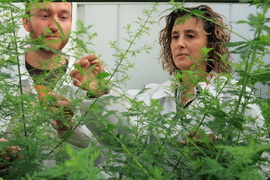
Scientists Discover Gene that Doubles Artemisinin Production in Artemisia annua Plant
March 29, 2017| |
 The plant Artemisia annua has been used for more than 2,000 years in traditional Chinese medicine to treat intermittent fevers. The artemisinin molecule – the active ingredient synthesized in this plant's trichomes – is the main component of malaria treatments worldwide. But the low content produced by the plant and the high cost of its chemical synthesis result in a scarce and costly drug.
The plant Artemisia annua has been used for more than 2,000 years in traditional Chinese medicine to treat intermittent fevers. The artemisinin molecule – the active ingredient synthesized in this plant's trichomes – is the main component of malaria treatments worldwide. But the low content produced by the plant and the high cost of its chemical synthesis result in a scarce and costly drug.
An international team of researchers led by the Centre for Research in Agricultural Genomics (CRAG) and Sequentia Biotech S.L. has been able to obtain, through genetic engineering, Artemisia annua plants that produce twice as much artemisinin. The research team has identified a gene involved in the formation of plant trichomes and in the synthesis of terpenes, such as artemisinin. The AaMYB1 gene has a dual function: it promotes trichome formation in the leaves and artemisinin synthesis inside the trichomes. Soraya Pelaz, CRAG researcher and senior author of the study said, "By manipulating this gene, we have managed to grow plants which contain much more artemisinin than their wild-type counterparts."
The researchers at CRAG designed transgenic plants that overexpressed the AaMYB1 gene and found that they accumulated larger doses of artemisinin than non-genetically modified plants. To confirm the role of AaMYB1 gene in trichome formation, they searched for similar genes in Arabidopsis thaliana and found the gene AtMYB61. When this gene was overexpressed in the model plant, the plant produced more trichomes.
For more details, read the article in CRAG News.
| |
Biotech Updates is a weekly newsletter of ISAAA, a not-for-profit organization. It is distributed for free to over 22,000 subscribers worldwide to inform them about the key developments in biosciences, especially in biotechnology. Your support will help us in our mission to feed the world with knowledge. You can help by donating as little as $10.
-
See more articles:
-
News from Around the World
- International Consortium Sequences Resurrection Plant to Develop Drought Tolerant Crops
- Study Reveals Farming Becoming Riskier Under Climate Change
- Canadian Farmers to Plant GE Potatoes for the First Time
- GAIN Reports Korea's New Biotech Labeling Requirements
- Pakistan's Sindh Seed Council Assesses 21 New Seed Varieties Including 6 Bt Cotton Varieties
- EFSA Releases Risk Assessment of Information on Subcombination of Events of Four-trait Maize Event
- Princess Anne Says Ruling Out GM Crops Not Practical
-
Research Highlights
- Nagoya University Discovers Molecular Shoot-to-root Signal System in Nitrogen-starved Plants
- Overexpression of Del Gene from Snapdragon Improves Anthocyanin Accumulation and Abiotic Stress Tolerance in Tobacco
-
Beyond Crop Biotech
- Wageningen Researchers Release Detailed Genetic Map of Roses
- Scientists Discover Gene that Doubles Artemisinin Production in Artemisia annua Plant
-
Resources
- The Green G-Nome's Guide to GM Crops and Policies in the EU
- #KnowtheScience Social Media Campaign
-
Plant
- Development of Barley with Heritable Disrupted ENGase Gene via CRISPR-Cas9
- DNA Methylation Affects the Efficiency of TALEN-mediated Genome Editing in Rice
-
Read the latest: - Biotech Updates (November 12, 2025)
- Gene Editing Supplement (October 29, 2025)
- Gene Drive Supplement (February 22, 2023)
-
Subscribe to BU: - Share
- Tweet
